Introduction
Human societies have evolved to create economic systems for managing scarce resources (Harari, 2015). In turn, it was believed that the economic system had no natural limits to growth (Georgescu-Roegen, 2005). However, by the law of entropy, every economic action generates waste, reducing the quantity and quality of natural resources for use by future generations (Cechin & Veiga, 2010; Georgescu-Roegen, 2005). This first notion of bioeconomy and sustainability only found fertile ground in the final decades of the 20th century and earlier decades of the 21st century, when advances in televised ecological disasters caused by human action began to attract the attention of the scientific community and move civil society (Cechin & Veiga, 2010).
In this sense, based on innovation and generation of knowledge from biotechnology, replacement of fossil resources by renewable ones, reuse of waste, in bioecology and appreciation of ecosystem services, Bioeconomy, as a result of the interaction and association between economy and environment, includes improvements in the areas of human and animal health, agriculture, industry, information technology, cosmetics, energy and engineering, allowing for sustainable development (Birner, 2018; Bugge et al., 2016; Martinho & Jacquinet, 2020).
At the same time, research on stakeholder perceptions is useful as it allows understanding the challenges encountered in accepting and incorporating Bioeconomy into society and how stakeholders influence the transition processes from the traditional economic system to the bioeconomical one. In this context, knowing the students’ perceptions is necessary, as they will act as a qualified workforce for sustainable and biotechnological development, and they will be the future leaders of nations, that is, the more they know and support the cause, the more Bioeconomy will be strengthened, envisioning a sustainable future. Furthermore, these analyses allow identifying gaps in students’ knowledge, which can and should be incorporated into the teaching of educational institutions. However, the vast majority of studies carried out in the field of Bioeconomics are concentrated in the areas of natural sciences, biotechnology and engineering (Bugge et al., 2016).
Since there are few studies in the field of social sciences, and even less studies that intend to compare countries in different continents and different areas of knowledge, in addition to social relevance, the present study has academic relevance. This way, the study aims to analyze the knowledge and perceptions about Bioeconomy of young Brazilians aged between 18 to 28 years old enrolled in higher education. To this purpose, the research used a questionnaire to collect the data, totaling 220 respondents. Later, the collected data were analyzed quantitatively using the IBM SPSS Statistics software version 28.0.
In order to make its understanding cohesive, this study is divided into 6 sections. The first three comprise the bibliographical analysis, with the objective of conceptualizing and contextualizing Bioeconomy, analyzing its development in Brazil and, finally, analyzing related studies about the knowledge of young people about Bioeconomy. Next, the methodological procedures are described, followed by the research results and discussion. Finally, the conclusion lists the main findings, contributions and limitations of the study, as well as future research.
Multiple Facets of Bioeconomy
The process of global socioeconomic development centered on exponential progress has caused numerous adverse consequences, including mass emission of polluting gases, loss of biodiversity, water pollution, generation of hunger and poverty, dependence on the use of fossil fuels, desertification, accumulation of waste, and, in the background, this logic triggered conflicts between nations and the destruction of cultures and traditional knowledge (Birner, 2018; Dallendörfer et al., 2022; Horlings & Marsden, 2011; Urmetzer et al., 2020). At a global level, it was at the beginning of the 1980s and 1990s that the international community began to raise concerns about the harmful consequences of this production and consumption model, and it is in this context that Bioeconomy emerges as a potential alternative (Birner, 2018).
However, the description of the term was associated with Georgescu-Roegen, in 1975, in which the author brings to light the need for a conversion from classical economics to Bioeconomy, in which the economic system is no longer seen as cyclical, but as a generator of waste and consumer of scarce natural resources. In other words, the economy uses natural resources and returns waste to it, with a close connection between nature and economy, as one influences the other, starting to understand the “economy as part of a living and active ecosystem” (Cechin & Veiga, 2010), and it is from this observation that the term ‘Bioeconomy’ was born.
However, it was only in the 2000s that the number of research studies related to Bioeconomy increased. However, in 2016, the majority of publications came from researchers from developed countries in North America and Europe, covering the most varied areas of research with an emphasis on biotechnology (Bugge et al., 2016). From this, numerous conceptual definitions for Bioeconomy are found, the first of which from the 20th century strongly associated it with the replacement or innovation of products and production processes based on fossil sources with renewable-based ones with the use of biotechnologies, that is, Bioeconomy was, due to its conceptualization, linked to the notion of development as economic growth with the purpose of increasing the international economic competitiveness of countries through product substitution and innovation, encompassing socio-environmental issues in the background (Birner, 2018).
However, after the definition of sustainable development by the United Nations (UN), Bioeconomy becomes part of sustainable development strategies, contributing to the achievement of the Sustainable Development Goals (SDG), namely SDG 2, 3, 6, 7, 8, 9, 11, 12, 13, 14 and 15, using biotechnology, chemistry, engineering and biorefinery, with the aim of mitigating the adverse effects of the capitalist production and consumption model, proposing viable development alternatives that consider the economic, social and environmental aspects (Birner, 2018; Martinho & Jacquinet, 2020).
However, to encompass the social sphere with active participation and acceptance from individuals, it is necessary for the public to actually know what Bioeconomy is, its characteristics and aspirations through transformative knowledge (Urmetzer et al., 2020). To achieve this, Bioeconomy must be considered as a multifaceted concept that seeks to bring economy and nature closer together. Thus, to assist in its understanding, Bugge, Hansen and Klitkou (2016), identified and classified the three aspects most commonly defended by researchers, namely:
- a) Biotechnology: focused on innovation to develop marketable products as a form of economic differentiation and generation of qualified jobs. It is the most criticized view for condoning development as synonymous with economic growth;
- b) Bioresources: focuses on the research and development of materials/technologies and products that aim to replace the use of fossil resources with biological/renewable-based resources, recycling and creation/remodeling of value chains, aiming for economic growth that respects sustainability;
- c) Bioecology: commits to emphasizing the importance of ecosystem services provided by nature, valuing regional development.
Despite their differences in focus and action, it is possible to identify a point of intersection between them, namely the search for greater efficiency in the use of raw materials of biological origin, requiring a visualization of the three aspects together, as one can come to help the other.
Bioeconomy in Brazil
Brazil, due to the colonization process and the development project adopted, was slow to recognize the need for sustainability. However, according to Fagundes and Aragão (2017), it is considered that the country has a very fertile field for the development of Bioeconomy, as the country brings together diverse environmental and production conditions that provided the opportunity for a bioeconomic transition, mainly due to:
- i) having the greatest biodiversity on the planet;
- ii) having the lowest costs in biomass production, mainly sugar cane;
iii) having advanced tropical agriculture, based on the application of science and technology.
In terms of regulation, some laws have been developed in recent decades in order to provide the transfer of technologies, legal security, environmental protection and ecological resources against biopiracy (Maciel, 2014).
Combined with legislation, the country began to make large investments in renewable energy, with a focus on hydroelectric plants and the pro alcohol program (use of biomass to produce alcohol-ethanol to replace fossil gasoline), but only in 1980 investment in biotechnology began with the Biotechnology Sector Fund, which was one of the pillars for the country’s technological development (Fagundes & Aragão, 2017). Thus, with the gradual increase in investments in the biotechnology and education sectors, there was a significant increase in public and private companies using biotechnology. In a survey carried out in 2021, the Biotech Brazil platform listed 563 national and multinational biotechnology companies headquartered in the country (Profissão Biotec, 2021), and in 2018, 90% of these were considered micro, small and medium-sized companies and 70% had a formalized relationship with Brazilian universities (Alves et al., 2018).
These numbers illustrate the importance of Bioeconomy in Brazil, also highlighting that only until 2014, 42.2 million hectares in the country were cultivated with some assistance from biotechnology, such as biofertilizers, natural enemies, biocides, biogas (biodigestors), use of Non-Conventional Food Plants, and above all with the use of Genetically Modified Organisms (Fagundes & Aragão, 2017; Torres, 2022). Many of these biotechnologies were developed thanks to public research institutions such as the Brazilian Agricultural Research Corporation (Embrapa) and federal and state Universities and Institutes (Fagundes & Aragão, 2017). These initiatives are also reinforced as a consequence of the increase in internal and external demand for organic products or those with low environmental impacts, that is, more than socio-environmental responsibility, Embrapa sees Bioeconomy as a way of gaining space in a niche market and as a differentiator factor of Brazilian products on the international market.
In another line of development focusing on socioeconomic development projects, the National Program for Strengthening Family Agriculture for small and medium-sized farmers has aspects that seek to include farmers who are interested in making the transition from the conventional production system to the agroecological one, contributing to the inclusion of new farmers (Fossá et al., 2020). Furthermore, there are public purchasing programs, known as institutional markets, such as the National School Meal Program, the Food Acquisition Program and social assistance through income transfers such as Family Scholarship and Zero Hunger, which sought to facilitate the distribution and access of needy families to healthy food and policies to expand public universities and to distribute research grants.
Therefore, despite presenting the ideal natural conditions for the evolution and transition to Bioeconomy and some efforts by public authorities, the future of Bioeconomy in Brazil is uncertain. There are problems with the reduction in investment in science and technology after 2016, lack of investment in infrastructure, lack of a common policy for Bioeconomy in the country, lack of qualified human resources, increase in deforestation and destruction of biomes, doubts about acceptance by consumer market for Brazilian products and uncertainties about the viability of the competitiveness of these products in the international market (Torres, 2022). Even so, there is a greater focus on the visions of bioresources and biotechnology, which are almost completely related to the economy, having a secondary concern with bioecology.
Young People’s Perceptions about Bioeconomy
Currently, there are few studies that analyze the population’s perception, and those that do it generally focus on thematic areas surrounding Bioeconomy (Dieken et al., 2021; Dallendörfer et al., 2022; Výbošťok et al., 2022). In this sense, the choice of stakeholders is interesting because it focuses on understanding the awareness of the topic by groups of people who have a connection with Bioeconomy and who, in the future, will be responsible for implementing it. That is, these analyses allow a prelude to the direction of Bioeconomy because, in order to achieve the desired scope of social transformation, it is necessary to have social acceptance and to be incorporated into the population’s everyday life, provoking discussions and actions that transcend the triangle of companies, government and academia (Dieken et al., 2021; Výbošťok et al., 2022).
Furthermore, related research is restricted to the European continent, with similar analyses not being found in emerging countries. Furthermore, there is a gap in studies that encompass the social and ecological concerns of Bioeconomy and, even when the subject is included, it is clear the lack of these concerns among the interest groups studied (Výbołņok et al., 2022).
In a study carried out with the German population, Dallendörfer et al. (2021) found that there is still no great familiarity with the topic, but a majority of German citizens associate it with environmental protection, sustainability and economy, demonstrating strong support for the development based on Bioeconomy (33%), being in favor of the use/replacement of fossil energies with renewable ones, use of biological products, but strongly against genetic engineering used in agriculture, industry and, to a lesser extent, medicine. I
In the specific case of young people, Masiero et al. (2020), in a study carried out with students in the areas of forestry engineering at undergraduate, master’s and doctoral levels in 9 European countries, concluded that 70% of the students recognize the term Bioeconomy and 90% of them would like to have Bioeconomy more present in their academic trajectory. Thus, Masiero et al. (2020) conclude that due to the multiple facets of the Bioeconomy concept, its understanding is also varied depending on the student, academic degree, education level and the European region (especially the northern region).
In the same line of research, Výbošÿok et al. (2022) surveyed students from undergraduate and master’s degrees in forestry and related engineering in Slovakia. Among the survey results, 69% of the students had already heard of the term and, consequently, there is a high perception of the importance of Bioeconomy for forestry uses, a recognition of the importance of the bioenergy, biofuels and forestry sectors for the development of Bioeconomy. Similarly, in the study by Masiero et al. (2020), the main source of associated information is the university (31%), news (31%) and social networks (22%). In another similar survey carried out in Poland, unlike the results of the surveys mentioned above, 68% of the students have never heard of Bioeconomy and 13.4% had contact with the subject at university, but 70% are interested in studying more about the subject after a brief explanation (Drejerska, 2017).
Furthermore, seeking to understand the social part of Bioeconomy, the research carried out by Stern et al. (2018) highlights the division between students who associate Bioeconomy with biotechnology or environmentalism, which is in line with the results of Masiero et al. (2020) in which most respondents associate it with biotechnology and bioecology. Therefore, the studies brought to light speak to each other and are emphatic in the part in which Bioeconomy is concerned with society and its course and not just with the economy, as it does not only consider changing the production process but rather remodeling the socioeconomic system through environmental and political awareness among governments and the population. Although, currently, the most observed is Bioeconomy applied in restricted dimensions such as modifying the productive and economic process within companies, governmental and academic actions.
Research Methodology
The study consists of an analytical, cross-sectional and quantitative research study whose purpose is to analyze the associations between the variables of interest using a questionnaire applied to higher education students of Brazilian nationality. The survey is useful to determine trends and perceptions of the analyzed population, in this case the perception of Brazilian students about Bioeconomy, and to study the association between the variables (Creswell & Creswell, 2021). Therefore, the research aims to study students who meet the following selection criteria:
- a) students regularly enrolled and attending higher education (undergraduate and postgraduate);
- b) aged between 18 and 28 years old, belonging to Generation Z;
- c) of Brazilian nationality.
Therefore, to choose the sampling unit, a non-random for convenience sampling was chosen, as there is no intention of being a statistically representative survey at a national level. Therefore, the objective was to reach as many respondents as possible who fit the selection criteria. To collect data, it was used a questionnaire adapted from Dallendörfer et al. (2022) that was built on the Google Forms platform and published on the researchers’ social networks and sent via email to known addresses. Regarding the structure of the questionnaire, it was divided into two sections. To characterize the respondent, the first section included questions of socioeconomic nature such as: gender, age, residence, household size, number of dependent household members, monthly household income level, educational institution attended and knowledge area. The second section encompasses 11 questions about respondents’ knowledge about Bioeconomy.
To classify the level of knowledge, a true/false question was used in which questions correctly identified as true and/or false were assigned 1 point, questions incorrectly selected as true and/or false or “I don’t know” were assigned 0 points. Then, a qualitative scale and/or a quantitative scale were used, applying the following correspondence between the scales:
(1) 0% – 19%: “Weak” knowledge level;
(2) 20% – 49%: “Insufficient” knowledge level;
(3) 50 – 69%: “Sufficient” knowledge level;
(4) 70%-89%: “Good” knowledge level;
(5) 90% – 100%: “Very Good” knowledge level.
Later, the data were analyzed using the IBM SPSS Statistics software, version 28.0, for univariate, bivariate and multivariate statistics. Thus, frequencies (absolute and relative) were calculated for nominal and ordinal (qualitative) variables and central tendency measures (mean, mode and median) and dispersion measures (standard deviation, minimum and maximum) were calculated for superior (quantitative) variables (Pestana & Gageiro, 2014; Marôco, 2021).
After testing the homogeneity of variances using the Levene’s test and the normality of the data using the Kolmogorov-Smirnov with the correction of Lilliefors test, the lack of homogeneity of variances and normality of the data had, as consequence, the use of non-parametric tests, namely Mann-Whitney test (to compare two independent samples) and Kruskal-Wallis test (to compare more than two independent samples) as alternatives to the T-Student and ANOVA One Way tests, respectively (Pestana & Gageiro, 2014; Marôco, 2021).
Finally, a multiple regression model was developed to estimate the associations between the “sustainable Bioeconomy concept” and other independent variables. This method estimates the association by minimizing the sum of squares in the difference between the observed and predicted values of the dependent variable (Pestana & Gageiro, 2014).
Furthermore, it should be noted that prior to accessing the questionnaire, respondents were informed about the objectives of the research, as well as the investigative nature of the research, with the voluntary nature of their participation and confidentiality being clarified, with no possibility of individual identification of any respondent. Therefore, the informed consent form respects the General Data Protection Regulation (Law no. 58/2019) guaranteeing total anonymity and confidentiality of the data.
Results and Discussion
Of those interviewed, 56.4% identify as female, 42.3% as male and 1.4% as non-binary. The number of men and women interviewed reflects the reality of the country, where women represented 57.05% of students enrolled in higher education in 2020 (INEP, 2021). In terms of age group, due to the inclusion factor of the research (young people aged between 18 to 28 years old), two large age groups were classified, 48.2% from 18 to 21 years old and 51.8% over 21 years old, as shown in Table 1.
In relation to household income, those with income between 1 and 2 Portuguese minimum wages (46.8%) stand out, followed by respondents with an income of less than 705 euros (35.9%) and between 2 and 3 minimum wages (10.5%), as shown in Table 1. It is worth noting that income was expressed in relation to the Portuguese minimum wage, as the research was carried out at the Institute Polytechnic of Bragança, in Portugal, and Brazilian students residing in Portugal were also surveyed.
Regarding the residence, 51.4% stated that they lived in rural areas and 48.6% in urban areas (Table 1). This result is interesting to analyze considering that according to data from 2015, 84.72% of the Brazilian population lived in urban areas (IBGE, 2015). One explanation for more than half of the respondents identifying themselves as rural residents is the divergence between the way government agencies and citizens classify rural and urban areas, and also as a result of the expansion policy of federal universities and institutes (started in 2005) to regions closer to rural areas as a way of providing opportunities for rural young people enrolling in higher education.
Regarding the size of the household, Table 1 shows that households with 3 and 4 people stand out (23.6 and 33.2%, respectively). Also regarding the family, 38.6% of the respondents claimed to not have financial dependents. Data on household size and number of dependents reflect the downward trend in birth rates in countries, representing a decrease in the household size.
Regarding the scientific knowledge areas (Table 1), the respondents were classified according to the areas recognized by the Coordination for the Improvement of Higher Education Personnel into eight groups, with the areas with the greatest coverage among respondents being Agricultural Sciences (27.7%), Engineering (26.4%) and Applied Social Sciences (16.8%).
Table 1: Sociodemographic characterization of the sample
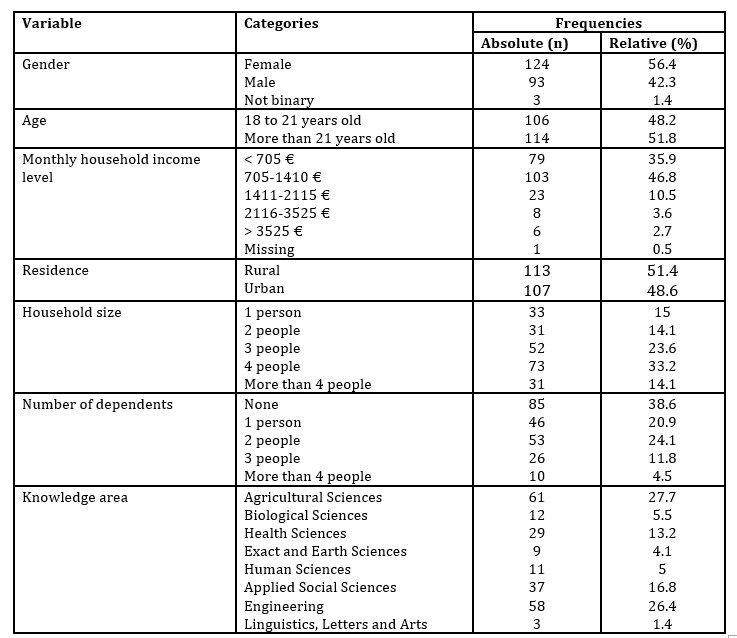
By allowing any Brazilian student enrolled in a higher education institution to have access to the questionnaire, students were identified from 37 institutions divided into the South, Southeast, Center-West, Northeast of Brazil and Portugal. Consequently, 29.1% of the respondents were from the Institute Polytechnic of Bragança (IPB) due to the great incentive for student exchange programs between IPB and Brazilian public and private institutions, and the fact that the research was carried out within the IPB itself. The second university highlighted is the Federal Technological University of Paraná (UTFPR), as shown in Figure 1.
Regarding familiar concepts that relate to Bioeconomy, and even itself, as shown in Figure 2, familiarity with the concept “Bioeconomy” is 53.2%, closer to the value found in the research carried out by Výbolťok et al. (2022) in which 66% of the students know the term and, in Masiero et al. (2020), 70% of the forestry students recognize it. However, the research by Výbolťok et al. (2022) was carried out with students from courses in areas related to Bioeconomy (biology and forestry, for example), which can increase their knowledge on the subject. Furthermore, students are more familiar with the concepts of Green Economy (57.3%) and Recycling Economy (51.4%), and less with Shared Economy (32.7%) and Linear Economy (38.6%). In the study by Mehta et al. (2021), students tend to strongly associate Circular Economy with Bioeconomy, especially with regard to recycling, emphasizing the need to link the principles of Circular Economy to Bioeconomy.
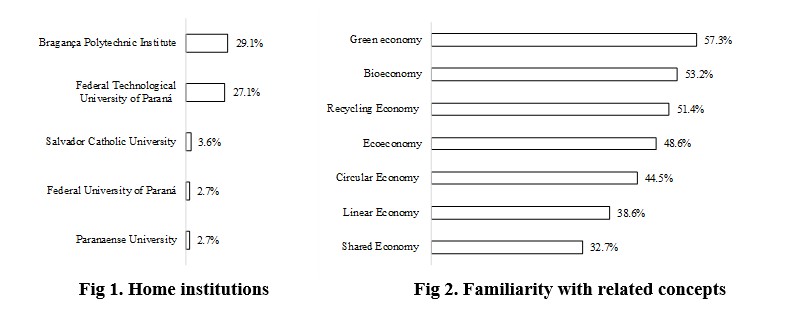
Additionally, referring to the students’ opinion on the process of replacing fossil resources with renewable ones aiming at the transition to a sustainable Bioeconomy in a scale ranging from 1 (I’m absolutely against) to 7 (I’m absolutely in favor), the response of Brazilians was closer to 7 with a mean of 5.9 (SD = 1.423) and a median equal to 7, corroborating the research by Dallendörfer et al. (2022) in the German population. This way, it can be understood that, despite being in favor of the process, many do not know specifically what this means in practice.
Taking into account the distribution of respondents by level of knowledge, Figure 3 shows that Brazilian students presented higher level of knowledge classified as Very Good (9.5%) and Good (37.7%), which combined correspond to 47.2%. However, even recognizing the term, the in-depth knowledge is less than desired.
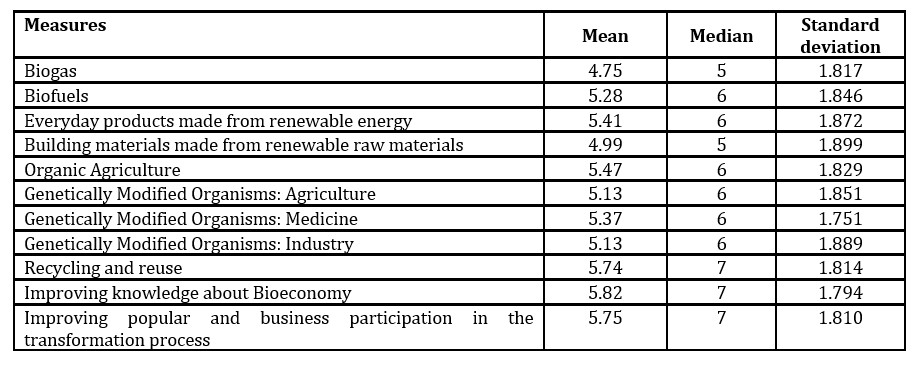
Fig 3. Respondents distributed by level of knowledge
To determine the knowledge level about Bioeconomy, statements were prepared with three answer options, namely “True”, “False” and “I don’t know”. Based on the answers, the knowledge level was classified ranging from 0 to 100%. The answers in Table 2 explain the understanding of Bioeconomy as something related to the replacement of fossil resources by renewable-based ones, linking with the Bioeconomy vision of bioresources.
Table 2: Statements marked correctly and incorrectly by respondents

(1) false statement; (2) true statement.
Regarding the measures to be implemented in a possible transformation plan for Bioeconomy, presented in Table 3, Brazilian students were in favor of implementing a bioeconomic plan that encompasses the multiple forms of Bioeconomy, with response averages mostly above 5 and median equal to 6.
However, the implementation of management forms that facilitate the use and production associated with Biogas was the least mentioned by Brazilians (Table 3), corroborating Dallendörfer et al. (2022). Furthermore, the best evaluated measures are those of a social nature to improve the general population’s knowledge about Bioeconomy, an issue for which there was also strong support from a large proportion of the respondents in the Masiero et al. (2020) and Dallendörfer et al. (2022) research; and greater popular and private participation in transformation processes, followed by broad support for recycling and reuse found in Mehta et al. (2021) research.
Furthermore, there is less support in the sphere of production and use of construction products and materials made from renewable energy and materials (Table 3). Contrary, the strong support for the use of renewable construction materials can be seen in the study by Kylkilahti et al. (2020). In terms of organic agriculture, there is high Brazilian acceptance, as in the research carried out by Dallendörfer et al. (2022) in Germany. Also, there is wide acceptance of Genetically Modified Organisms (GMO), as there is a wide range of GMO products produced and sold in the country.
Table 3: Measures that would be implemented if respondents were responsible for developing a transformation plan for Bioeconomy
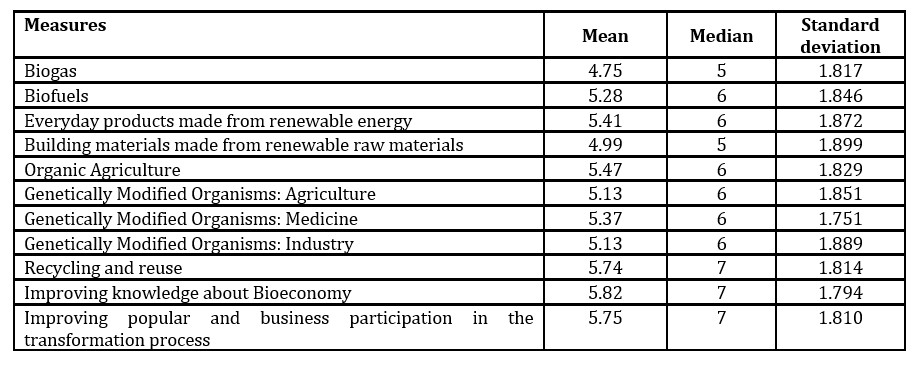
Regarding the contributions of Bioeconomy, students demonstrate great confidence that it would be able to contribute to the reduction of problems associated with the environment, mainly in the reduction of plastic waste and carbon emissions (Table 4). However, the concern with nitrate infiltration into water was the most prominent item for the option ‘can be increased’, which may be related to the expansion of agricultural frontiers and the exacerbated increasing use of nitrogen fertilizers which, when applied incorrectly, is leachate causing eutrophication of water bodies.
Table 4: Environmental concerns that may be impacted by Bioeconomy (%)

Regarding socio-environmental issues linked to Bioeconomy, improved access to research and innovation, the achievement of a sustainable development model and the generation of new jobs are the aspects most highly evaluated by Brazilian students. However, it is noted that there is a positive attitude towards socioeconomic aspects in relation to environmental ones (Figure 4).
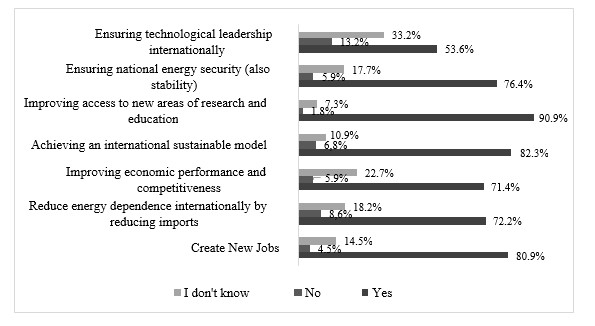
Fig 4. Contributions of Bioeconomy to society, environment and economy
Next, students assessed their self-knowledge on topics related to Bioeconomy. In this way, it appears that there is great knowledge on the topics, especially decarbonization, genetic engineering in agriculture and the cultivation of energy crops, but with little in-depth (Figure 5). However, Brazilian students presented deeper knowledge about aspects linked to agriculture (genetic engineering in agriculture, gene editing technology and digitalization in agriculture) and the SDG. This question is related to the socioeconomic significance of agriculture for the country, with great publicity in the media and high investments in research and innovation in the sector also with regard to sustainable agriculture as a way of fulfilling the SDG and the incorporation of the topic in schools and universities (Figure 5).
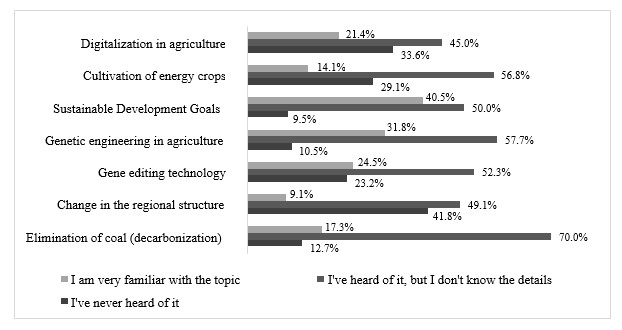
Fig 5. Knowledge on topics relevant to Bioeconomy
Reflecting the support for recycling measures, biofuels and the use of products of recycled origin presented in Table 3, the pro-environmental actions most carried out by the respondents are purchasing regional and organic products, changing mobility behavior, using returnable packaging and renewable energies (Table 5).
The purchase of these products is facilitated through open-air markets and fair-trade networks; in this sense, both the municipality of Bragança, home of the IPB, and Pato Branco, home of the UTFPR, where most of the respondents come from, have open-air markets and markets for regional and organic products (Tomazini et al., 2022), and signal the trend of increasing production for this range of products (Friedmann & McMichael, 1989). However, the purchase and/or compensation of CO2 was an action that was rarely carried out. An argument for this result is that this action is generally carried out by companies and/or entities that seek to repair their damage to the environment through the purchase of CO2 credits or compensatory measures such as reforestation, and not by individuals. Therefore, comparing the data presented so far, as found by Rodrigues (2017), in a study with civil engineering academics in Brazil, it is possible to understand that there is an association between pro-environmental behavior and support for sustainable initiatives to the extent that can trigger economic benefits for respondents, notably with regard to the increase in demand for jobs for qualified professionals, that is, future graduates.
Table 5: Pro-environmental actions carried out by the respondents in the last 12 months (%)

When asked about the sources of information on Bioeconomy, respondents have less trust in the national government, journalists and local government with medians of 3, 4 and 4, respectively (Table 6). Dissatisfaction with information vehicles and the Brazilian government is observed after a series of corruption scandals, secrecy in the transmission of relevant information, lack of transparency and impartial journalism. Therefore, just like the Germans, in the study by Dallendörfer et al. (2022), the highest degree of trust among Brazilian students goes to scientists.
Table 6: Trust in the sources of information on Bioeconomy

Despite numerous studies demonstrating that women are more likely to demonstrate interest and knowledge in topics related to sustainability, especially socio-environmental issues (Kagawa, 2007; Alonso-Almeida et al., 2017), the results presented in Table 7 do not allow rejecting H0, which leads to the conclusion that there are no statistically significant differences considering the gender. That is, the knowledge level between female and male is equal, corroborating with studies of Pätäri (2017) and Dallendörfer et al. (2022).
Also testing the knowledge level taking into account age, the results show that age is not a differentiating factor of the knowledge level, even though studies indicate that as age increases, the importance given to sustainability and socio-environmental responsibility increases as well (Eweje & Brunton, 2010; Pätäri et al., 2017). Taking into account the residence, the results of the Mann-Whitney test prove that there are statistically significant differences in the knowledge level for Brazilians, with a higher knowledge level about Bioeconomy in Brazilian students residing in urban areas. A possible explanation for this is that residents of urban areas still have easier access to information resources than residents of rural areas due to problems related with access to the Internet and libraries, and even those who left rural areas to study/work in cities, they may still have difficulties in assimilating knowledge that is related to their experience in the countryside. Furthermore, for the knowledge level according to the scientific area of the degree attended by the students and the household’s income level, no statistical differences were observed (Table 7).
Table 7: Knowledge level about Bioeconomy according to sociodemographic variables
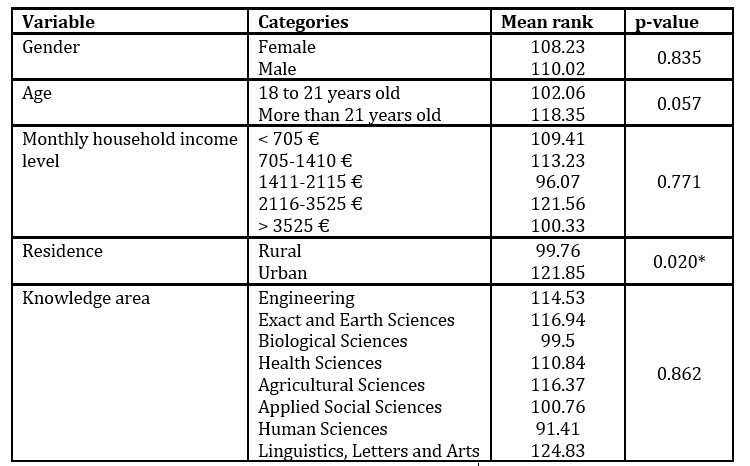
* There are statistically significant differences at a significance level of 5%
According to the results shown in Figure 6, the model presents an R2 = 0.172, that is, the set of independent variables explains 17.2% of the variance of the dependent variable “Sustainable Bioeconomy Concept”, thus identifying a statistically significant correlation between the variables of environmental and economic benefits with the dependent variable on the concept of sustainable Bioeconomy. That is, greater knowledge about the concept of sustainable Bioeconomy results in a greater belief that Bioeconomy is capable of presenting positive results in the economic and environmental spheres, especially in environmental benefits, also reflecting its support. This result is corroborated by Dallendörfer et al. (2022) study which considers that the effects on the economic sector are more perceived by the public, having a strong appeal.
Furthermore, the model shows significance in the association between the sociodemographic variable “knowledge area” and the dependent variable. In this sense, according to the results presented in the regression analysis, the sociodemographic characteristics of the respondents, with the exception of the knowledge area, do not affect their discernment about sustainable Bioeconomy.
However, showing significance in the model, the knowledge area of the degree attended by students has an influence on the dependent variable. Therefore, when analyzing the results of the bivariate analysis, even if not significant, a slight increase in knowledge about Bioeconomy can be seen for those attending degrees in the areas of Linguistics, Literature and Arts, Exact and Earth Sciences, Agricultural Sciences and Engineering. This result was expected given that these knowledge areas, with the exception of Linguistics, Literature and Arts, tend to relate to and explore Bioeconomy more effectively, especially with studies related to biotechnology. The explanation for the great knowledge about Bioeconomy in the Linguistics area may be related with the encouragement of teaching methodologies that encompass environmental issues, seeking to train professional educators capable of correlating these subjects with their future students.
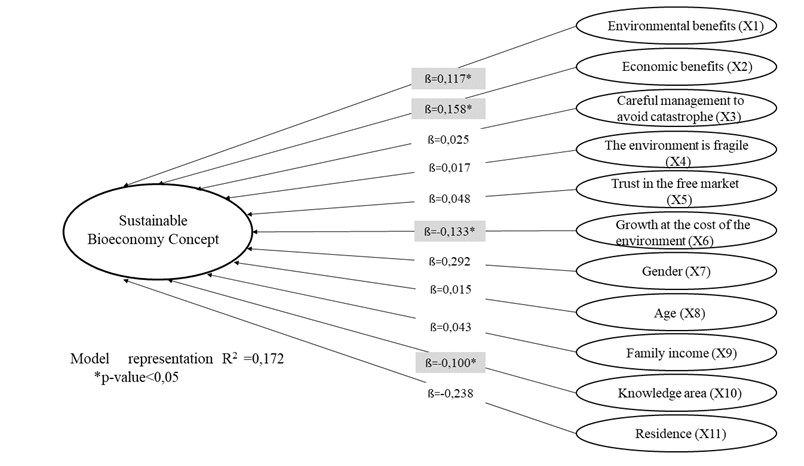
Fig 6. Estimated regression using “Sustainable Bioeconomy Concept” as the dependent variable
An inverse correlation is also identified between support for Bioeconomy and identification with the statement “we need more economic growth in the future, even if it affects the environment”. Therefore, as in the study by Dallendörfer et al. (2022), those who defend economic growth, even if there are controversial effects on the environment, are also those who have less knowledge and support for Bioeconomy.
Conclusions
In general, the results indicate that the economic benefits triggered by Bioeconomy have greater visibility and support from students compared to the environmental benefits. Among the possible economic benefits associated with the development of Bioeconomy is the generation of qualified jobs, increased competitiveness and economic differentiation of countries. However, there is a growing concern with environmental issues, with an inverse correlation between agreement with growth at the expense of the environment and support for Bioeconomy. This fact may be linked to the history of development of biofuels, bioproducts and genetic improvements of plant species in the country and its favorable soil and climate characteristics, which together stimulated investments in research areas related to Bioeconomy, also generating investments in the educational area, valuing the training of professionals capable of leading research and taking on qualified jobs. Likewise, environmental education is very developed in the country in the early school years.
However, the study highlights a gap in students’ knowledge about the topic, a factor that may explain why only just over 50% of them know it, with a great association between it and other related topics. Furthermore, the greater the knowledge level students have about Bioeconomy, the greater their support. That is, there is a direct correlation between knowledge and support.
However, due to the use of a non-probabilistic sample for convenience, a methodological limitation is created, as it does not allow the generalization of the results to the universe. Another limitation is related to the respondents who are part of the sample, since only young higher education students aged between 18 and 28 years old were included. This way, different age groups and those with different professional occupations were excluded. The inclusion of these groups would allow for a better understanding of the perceptions, perspectives and expectations of different generations with diverse experiences in relation to sustainability and Bioeconomy. To overcome these limitations, in future research, it is suggested to extend this study to other strategic audiences of different generations.
Acknowledgment
The authors are grateful to the Foundation for Science and Technology (FCT, Portugal) for financial support through national funds FCT/MCTES (PIDDAC) to CIMO (UIDB/00690/2020 and UIDP/00690/2020) and SusTEC (LA/P/0007/2020).
References
- Alonso-Almeida, M. del M., Perramon, J. and Bagur-Femenias, L. (2017). ‘Leadership styles and corporate social responsibility management: Analysis from a gender perspective.’ Business Ethics: A European Review, 26 (2), 147–161.
- Alves, N.G., Vargas, M.A. and Britto, J.N.P. (2018). ‘Interações universidade-empresa: Um estudo exploratório sobre as empresas de biotecnologia em saúde.’ Ecônomica-Niterói, 20 (1), 31–60.
- Birner, R. (2018). ‘Bioeconomy Concepts.’ In: Lewandowski, I. (ed.) Bioeconomy: Shaping the Transition to a Sustainable, Biobased Economy, Springer, Cham, pp. 17-38.
- Bugge, M., Hansen, T. and Klitkou, A. (2016). ‘What Is the Bioeconomy? A Review of the Literature.’ Sustainability, 8 (7), 691.
- Cechin, A.D. and Veiga, J.E. (2010). ‘A economia ecológica e evolucionária de Georgescu-Roegen.’ Brazilian Journal of Political Economy, 30 (3), 438–454.
- Creswell, J.W. and Creswell, J.D. (2021). Projeto de pesquisa: Métodos qualitativos, quantitativos e mistos, Penso, Porto Alegre.
- Dallendörfer, M., Dieken, S., Henseleit, M., Siekmann, F. and Venghaus, S. (2022). ‘Investigating citizens’ perceptions of the bioeconomy in Germany – High support but little understanding.’ Sustainable Production and Consumption, 30, 16–30.
- Dieken, S., Dallendörfer, M., Henseleit, M., Siekmann, F. and Venghaus, S. (2021). ‘The multitudes of bioeconomies: A systematic review of stakeholders’ bioeconomy perceptions.’ Sustainable Production and Consumption, 27, 1703–1717.
- Drejerska, N. (2017). ‘Employment in vs. Education for the bioeconomy.’ Proceedings of the 8th International Scientific Conference Rural Development, ISSN: 1822-3230, 23-24 November 2017, Kaunas, Lithuania, 991–998.
- Eweje, G. and Brunton, M. (2010). ‘Ethical perceptions of business students in a New Zealand university: Do gender, age and work experience matter?’ Business Ethics: A European Review, 19 (1), 95–111.
- Fagundes, R. and Aragão, C.A. (2017). ‘Bioeconomy in Brazil and in the World: Current Situation and Prospects.’ Revista Virtual de Química, 9 (1), 410–430.
- Fossá, J.L., Matte, A., Mattei, L.F. and Schneider, S. (2020). ‘Acesso e Distribuição do Pronaf entre Agricultores Familiares no Estado de Santa Catarina.’ Desenvolvimento em Questão, 18 (53), 222–244.
- Friedmann, H. and McMichael, P. (1989). ‘Agriculture and the state system: The rise and decline of national agricultures, 1870 to the present.’ Sociologia Ruralis, 29 (2), 93–117.
- Georgescu-Roegen, N. (2005). ‘Energia e Mitos Econômicos.’ Economia-Ensaios, 19 (2), 7–51.
- Harari, Y. N. (2015). Sapiens: uma breve história da humanidade, Elsinore, Amadora.
- Horlings, I. and Marsden, T. (2011). ‘Rumo ao desenvolvimento espacial sustentável? Explorando as implicações da nova Bioeconomia no setor agroalimentar e na inovação regional.’ Sociologias, 13 (27), 142–178.
- IBGE (2015). População Rural e Urbana: Pesquisa Nacional por Amostra de Domicílios Contínua (PNAD). Instituto Brasileiro de Geografia e Estatística. [Online], [Retrieved April 20, 2023], https://educa.ibge.gov.br/jovens/conheca-obrasil/populacao/18313-populacao-rural-e-urbana.html.
- INEP (2021). Censo da Educação Superior. Ministério da Educação/Instituto Nacional de Estudos e Pesquisas Educacionais Anísio Teixeira, Brasília.
- Kagawa, F. (2007). ‘Dissonance in students’ perceptions of sustainable development and sustainability: Implications for curriculum change.’ International Journal of Sustainability in Higher Education, 8 (3), 317–338.
- Kylkilahti, E., Berghäll, S., Autio, M., Nurminen, J., Toivonen, R., Lähtinen, K., Vihemäki, H., Franzini, F. and Toppinen, A. (2020). ‘A consumer-driven bioeconomy in housing? Combining consumption style with students’ perceptions of the use of wood in multi-storey buildings.’ Ambio, 49 (12), 1943–1957.
- Maciel, L.R. (2014). ‘A lacuna legislativa sobre biopirataria no Brasil e como mudar a atual situação.’ Thesis Juris, 3 (1), 224–242.
- Marôco, J. (2021). Análise Estatística com o SPSS Statistics, ReportNumber, Pêro Pinheiro.
- Martinho, A.P. and Jacquinet, M. (2020). Bioeconomia uma nova área de desenvolvimento económico (Tópico 3 EDS). Universidade Aberta de Lisboa, Lisboa.
- Masiero, M., Secco, L., Pettenella, D., …, and Wallin, I. (2020). ‘Bioeconomy perception by future stakeholders: Hearing from European forestry students.’ Ambio, 49 (12), 1925–1942.
- Mehta, N., Cunningham, E., Roy, D., Cathcart, A., Dempster, M., Berry, E. and Smyth, B.M. (2021). ‘Exploring perceptions of environmental professionals, plastic processors, students and consumers of bio-based plastics: Informing the development of the sector.’ Sustainable Production and Consumption, 26, 574–587.
- Pätäri, S., Arminen, H., Albareda, L., Puumalainen, K. and Toppinen, A. (2017). ‘Student values and perceptions of corporate social responsibility in the forest industry on the road to a bioeconomy.’ Forest Policy and Economics, 85, 201–215.
- Pestana, H. and Gageiro, J.N. (2014). Análise de dados para Ciências Sociais: A Complementaridade do SPSS, Edições Silabo, Lisboa.
- Profissão Biotec (2021). ‘Mapa Biotec: o novo levantamento de empresas de biotecnologia do Brasil.’ [Online], [Retrieved December 22, 2022], https://profissaobiotec.com.br/mapa-biotec-empresas-biotecnologia/
- Rodrigues (2017). Comportamento pró-ambiental, crenças e percepção de sustentabilidade na construção civil: uma análise de universitários ingressantes e concluintes, UNICESUMAR, Maringá.
- Stern, T., Ploll, U., Spies, R., Schwarzbauer, P., Hesser, F., and Ranacher, L. (2018). ‘Understanding Perceptions of the Bioeconomy in Austria—An Explorative Case Study.’ Sustainability, 10 (11), 4142.
- Tomazini, C.E.G., Kiyota, N. and Quinaglia, G.D.P. (2022). ‘A construção social dos mercados: Confiança e reciprocidade em circuitos curtos de comercialização.’ Colóquio, 19 (Edição Especial 1), 167–190.
- Torres, D.A.P. (2022). ‘Bioeconomia na Estratégia da Embrapa.’ In Torres D.A.P. (ed.) Em Bioeconomia: Oportunidades para o setor agropecuário. Brasília: Embrapa, pp. 219–243.
- Urmetzer, S., Lask, J., Vargas-Carpintero, R. and Pyka, A. (2020). ‘Learning to change: Transformative knowledge for building a sustainable bioeconomy.’ Ecological Economics, 167, 1–11.
- Výbošťok, J., Navrátilová, L., Dobšinská, Z., Dúbravská, B., Giertliová, B., Aláč, P., Suja, M. and Šálka, J. (2022). ‘Bioeconomy perception by students of different study programs – study from Slovakia.’ Central European Forestry Journal, 68 (2), 91–100.














